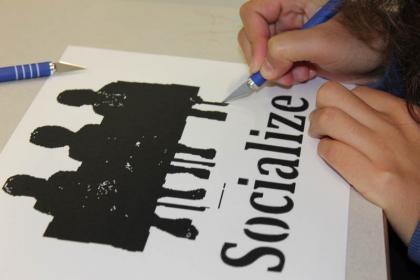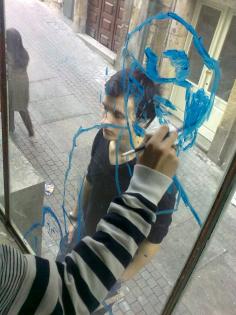
Example of a best practice. Community art project Interpreting voices
Introduction
IDEAlaboratory is a network-based platform operating under the auspices of the Contemporary Art Triennale for School Students Eksperimenta! where art teachers, artists and young people can exchange ideas and experience and, as customary in a lab, experiment and make new discoveries. The IDEAlaboratory of Eksperimenta! is a wider framework for workshops, training programmes, networking - cooperation taking place both in the physical and virtual space. In this article I am going to discuss one of its parts - the online platform for sharing best practices in the teaching of contemporary art, located at http://www.eksperimenta.net/cat/best-practice/?lang=en.
The aim of the open online platform is to promote experience exchange and cooperation between art teachers, with the view to better integrate contemporary art into art lessons. The platform was initiated in the framework of the project "IDEAlaboratories: how to integrate contemporary art and art education" that was funded from the Comenius programme, but in vision we see it expanding. It is an open collection of learning materials - art teachers are welcome to use the uploaded best practices in teaching contemporary art within their everyday work. One is free to adapt the practices of others to their own context, and to reflect on their use. And naturally we welcome all art teachers to upload their own successful practices.
The platform of best practices as a tool for the learning and professional development of art teachers
The idea for an online platform for sharing best practices emerged from the need to exchange experience in the teaching of contemporary art. Contemporary art is social, contextual, problem-centred, interdisciplinary, addressing the issues that are current in the society. Teaching contemporary art still raises questions and problems for teachers. Compared to the teaching of classical or modernist art, where the criterion for evaluation was the level of realisticness or originality according to Efland et al (1996), the emphasis in the teaching of contemporary art is rather on the interpretation, cross- or intra-subject connections, inclusion and new media. At the outset of the project, during the mapping of problems, it turned out that similar issues pop up in the teaching of contemporary art in different countries (Estonia, Latvia, Finland, Portugal): 1) little experience in the teaching of contemporary art, partly owing to scant exchange of experience, the scarcity of pedagogical discussions, 2) little employment of ICT-based methods and opportunities, 3) the scarcity of good methods for teaching contemporary art.
An example of development of a best practice. Light drawing. Photo: Linda Vainomäe
Cooperation between teachers in teaching contemporary art
Those studying teachers’ education emphasise cooperation as a key factor in the professional development of teachers (Brownell et al, 2006; Gregson & Sturko, 2007; Milbrandt, 2006); in addition to the exchange of experience it has the potential to create a sense of community and colleagueship, as teachers become more caring professionals through mutual support (Gregson & Sturko, 2007). Cooperation between art teachers is considered particularly important because an art teacher often works alone in the school (Milbrandt, 2006; Conway et al, 2005) and has no opportunity to discuss successes and problems on a daily basis with colleagues. Cooperating with teachers of the same field, however, makes it possible to receive valuable feedback, which supports professional development (Lind, 2007). When discussing contemporary art, cooperative learning is especially appropriate, given that postmodern artists, too, often work in groups or cooperate with the community (Hardy, 2006; Milbrandt, 2006). Cooperation is more effective if the participants are active and sense their role as both givers and receivers. A. Bandura (2006), who is the originator of the social learning theory, has said that effective group performance is guided by collective intentionality. With this project, active cooperation began with the joint setting of the goals and has continued throughout the project. International cooperation, the exchange of experience, is a highly suitable method for teachers’ learning in the case of the teaching of contemporary art; active partners have a key role in giving substance to cooperation.
ICT options for cooperation in art education
Today, in the age of the Internet, cooperation need not take place only within a school or a country. Borders have expanded and it is easy to learn from the experience of colleagues located farther away. Online resources provide younger teachers the opportunity to receive expert advice and help more experienced ones to combat isolationism and consequential teacher burnout (Milbrandt 2006). The Internet and new media are part of our daily life, and teachers, too, often use the Internet for searching materials and learning these days. Internet-based learning can be seen from different angles; either technical or practical options, learning or cooperation can be central Stein et al (2011). Depending on the function ascribed to Internet-based learning, what is achieved varies as well. In this project, the emphasis is on cooperation between teachers and on learning from the practices of others. Accordingly, the online platform is technically simple and not overly regulated, to keep the technical side from putting limits on the content. The teacher can easily adapt his or her practice to the upload form.
Uploading their best practices encourages teachers to analyse and reflect on their practices. It has been found that an ICT-based environment supports the teachers’ reflective awareness of their own practice and leads them to elucidate their knowledge (Rasku-Puttonen et al, 2002). In the course of formalising his or her best practice, the teacher is inevitably forced to formulate the assignment performed, to analyse its process, successes and shortcomings. That also entails self-reflection, through which teachers become conscious of what was not conscious before and analyse the reasons behind their actions (Hoekstra & Korthagen, 2011). Reflection helps teachers to better understand and expand their professional activity and reflecting on problems leads to new activities (Marcos et al, 2009). Upon uploading the practices, art teachers - who are more used to visual self-expression - have considered the verbal expression and analysis of what was done as the hardest part. Formulating the practice may indeed pose a difficulty for art teachers, but the analysis and reflection involved in this help them understand their activity, learn and develop their professional practice. The form of the project allows one to write the analysis in the manner of his or her choosing. Learning takes place especially by analysing problems, hence the pedagogical analysis part can certainly include difficulties and the solutions found to them.

An example of a best practice. Interpreting voices. Photo: Jane RemmSharing methods for teaching contemporary art
In sharing best practices, the exchange of methods takes place at grass-root level, teachers share experience with each other, through a personal perspective. An advantage of this, compared to other learning options, is the practical nature of the examples - teachers share the employed methods and assignments, these are illustrated and the context has been explained. Sharing methods helps to contribute to the teachers’ "toolbox," they can find and try out those that suit them. Seeing and trying different methods also helps raise the motivation to teach contemporary art, it becomes easier and more exciting. A good example of the exchange of methods is drawing with light, which was shared as a best practice by Portuguese colleagues. After introduction on the website we have used this practice in two workshops and it has always generated positive feedback from students. Another good example is the methodology behind the assignments used in the project’s workshops and their execution, formalised as practices. For example, the urban space action carried out in Tallinn, where miniature sculptures were used to transform the urban space into a "stage" for one’s own story, made it possible to address art in public space, guerrilla art and interventionism in a witty fashion. In Portugal, while addressing community art, the personal stories of different people were interpreted through contemporary art forms, such as stencil, drawing, performance, installation. This method where the basis, or the story, remained the same made it possible to compare how the same story is expressed in different art forms and how the specific nature of the art form affects the story.
Example of a best practice. Small sculptures in city space
A learning aid and tool for every art teacher
The platform of best practices is open to all art teachers for sharing their best practices in the teaching of contemporary art. To upload a practice, an account must first be created at www.eksperimenta.net, after which you can log in and open the submission form located at http://www.eksperimenta.net/cat/best-practice/. The submission form is simple - write a short summary and a longer pedagogical analysis, the practice can be illustrated with photos or videos, data on the participants and the type of the practice should be added. In the analysis part, it would be useful to keep the pedagogical value and the practicability of the practice in mind. In order for other teachers to be able to adapt the practice to their context, it would be good to be as specific as possible with regard to the description of the work process, the methodology, materials, as well as the objective and, why not, also problems and successes. The latter also provide the basis for a wider pedagogical discussion. The practices are bilingual: in English and in the original language of the submitter. The first few dozens of practices were uploaded to the website by teachers from the partner schools to the project "IDEAlaboratories: how to integrate contemporary art and art education". The website includes diverse practices, there is animation, design, sculpture, drawing, photography etc.; there are successful assignments from art lessons, but also overviews of practices performed jointly in workshops.
Teachers are free to use the uploaded practices as sources of inspiration or as straightforward translations, adapted to their context. When a practice is used, it would be nice to read feedback on the success thereof, either in the form of a comment or, if it was changed substantially, as a new practice.
Summary
Art education is changing and learning is changing. Internet-based learning, international cooperation and exchange of knowledge have become commonplace. For the teaching of contemporary art, international cooperation is a highly suitable form of teachers’ learning. The IDEAlaboratory online platform for best practices is a good example of promoting international cooperation, mutual learning and broader discussion of contemporary art. Currently the website boasts several dozen good examples in various techniques and subjects. The platform of best practices is a practical tool and learning aid for an art teacher, to be used for inspiration, cooperation and mutual learning in order to bring diversity into art lessons and integrate contemporary art. We hope to see our vision come true - that art teachers around the world will start using the platform and it will contribute to a greater integration of contemporary art into art education. Come join us and share your experience as well!
References
Bandura, A. (2006). Toward a Psychology of Human Agency. Perspectives on Psychological Science, 1-2, 164 - 180.
Brownell, M., T., Adams, A., Sindelar, P., Waldron, N., Vanhover, S. (2006). Learning From Collaboration: The Role of Teacher Qualities. Council for Exceptional Children. 72-2, 169-185.
Conway, C.M., Hibbard, S., Albert, D., Hourigan, R. (2005) Professional Development for Arts Teachers, Arts Education Policy Review, 1, 1-9
Efland, A., Freedman, K., Stuhr, P. (1996). Postmodern Art Education: An Approach to Curriculum. Virginia: The National Art Education Association.
Gregson, J. A., Sturko, P. A. (2007). Teachers as Adult Learners: Re-conceptualizing Professional Development, MPAEA Journal of Adult Education, 1, 1 - 18.
Hardy, T. (2006). Introduction: Nailing Jelly: Art Education in a Postmodern World. In. Art education in a Postmodern World: Collected Essays. T. Hardy (Ed.). Bristol: Intellect Ltd.
Hoekstra, A., Korthagen, F. (2011). Teacher Learning in a Context of Educational Change: Informal Learning Versus Systematically Supported Learning. Journal of Teacher Education, 62(1), 76-92.
Lind, V. (2007). High quality professional development: An investigation of the supports for and barriers to professional development in arts education. International Journal of Education & the Arts, 2, 1 - 18.
Marcos, J., Miguel, E., Tillema, H. (2009). Teacher reflection on action: what is said (in research) and what is done (in teaching). Reflective Practice, 10(2), 191-204.
Milbrandt, M. K. (2006). A Collaborative Model for Art Education Teacher Preparation. Arts Education Policy Review, 5, 13-21.
Rasku-Puttonen, H., Etelapelto, A., Lehtonen, O, Nummila, L., Hakkinen, P. (2004). Developing teachers’ professional expertise through collaboration in an innovative ICT-based learning environment. European Joumal of Teacher Education. 27-1, 47 - 60.
Stein, S., J., Shepard, K., Harris, I. (2011). Conceptions of e-learning and professional development for e-learning held by tertiary educators in New Zealand. British Journal of Educational Technology, 42- 1, 145-165


No comments added